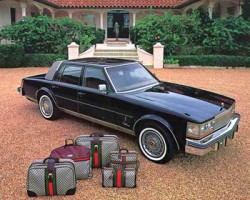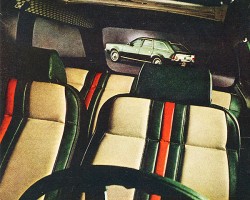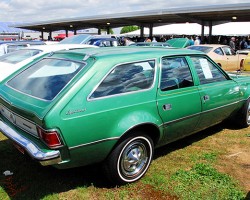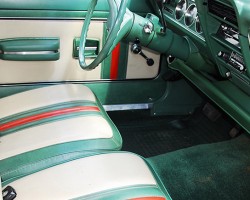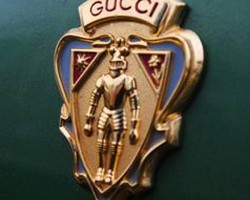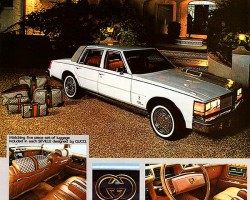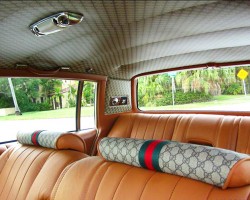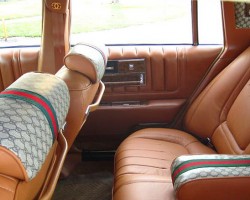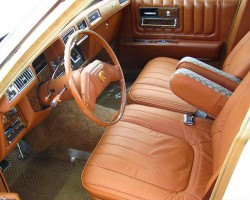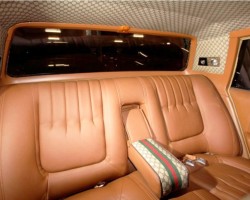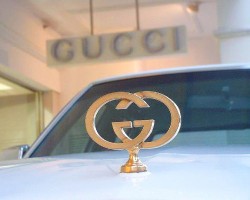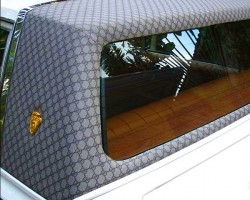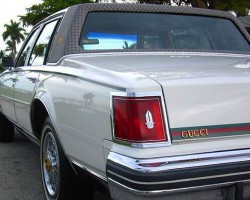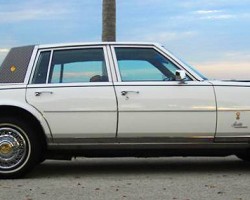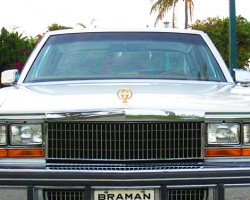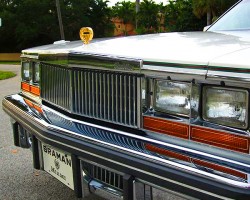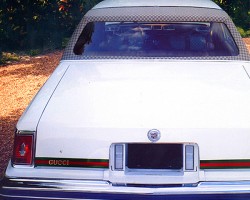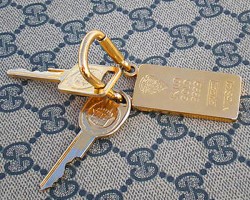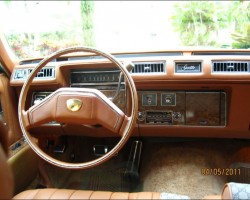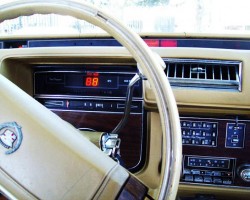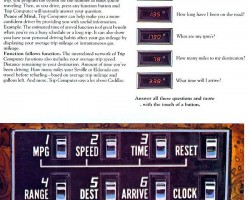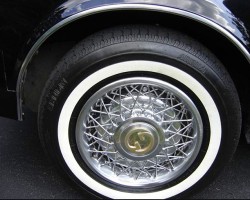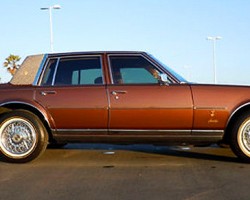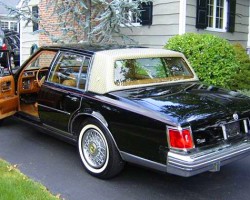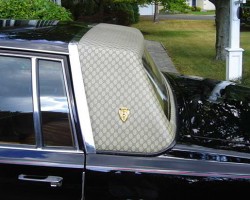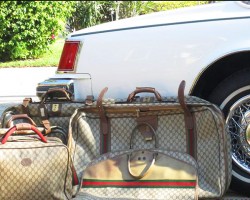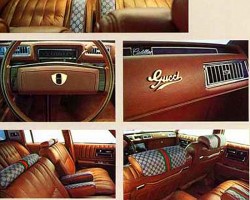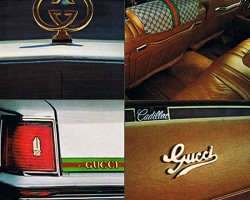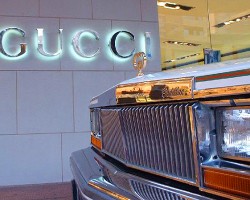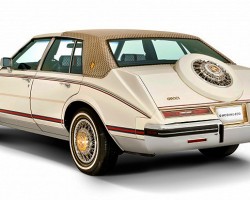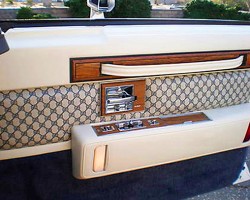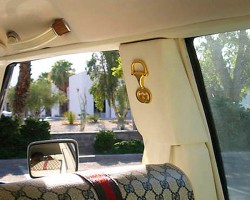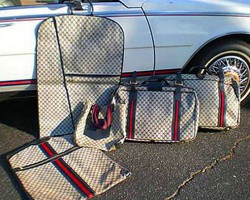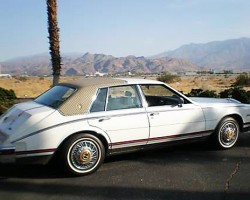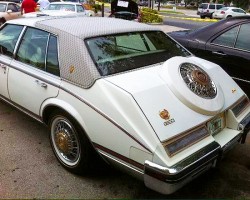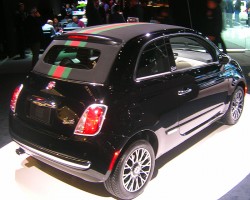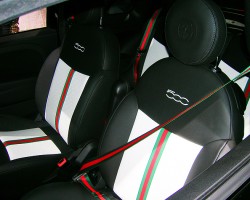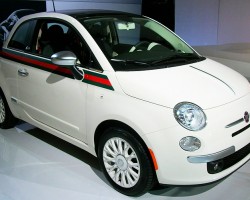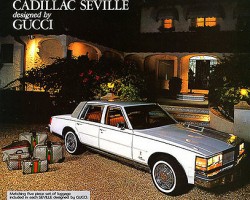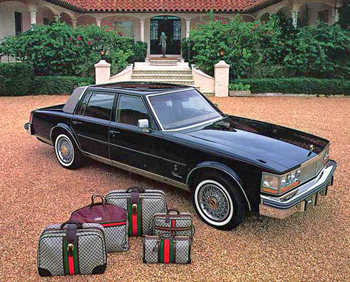
Gucci edition Cadillac Sevilles, like this 1978 model, came in white, black, and bronze…along with a set of matching luggage.
Introducing the company’s “Seville by Gucci” in 1978, Aldo Gucci proclaimed, “The Gucci styling we have created for this car is designed to give a fortunate few owners a rare possession of distinction, beauty and ultimate luxury”. He went on to indicate designing the car had been one of the most challenging and intriguing projects he had ever undertaken. While the Cadillac Seville may be the best-known Gucci branded automobile, it wasn’t the company’s first. Nor it’s last.
(A photo slideshow at end of article shows all years & models discussed)
GUCCI FIRST PAIRS UP WITH AMERICAN MOTORS
During the early 1970s American Motors Corporation (AMC) was taking a marketing direction no carmaker had before, reaching out to clothing designers to put their names on “designer” editions of its various car models. Agreements were forged with Levis, Pierre Cardin, and namely Gucci for the 1972 model year. Thus began Gucci’s foray into the automotive world, and the Hornet Gucci Edition was born.
Available only in the highest trim “Sportabout” station wagon for the 1972 and 1973, the $142 option package featured Gucci striped green/red/beige colors on vinyl seats and door panels. Gucci Edition exterior paint colors offered were snow white, hunter green, grasshopper green, and yuca tan. 2,584 Gucci Edition 1972 Hornets and 2,252 ’73 Gucci Edition Hornets were sold.
While many felt Gucci’s affiliation with American Motors economy cars devalued the double-G image, it’s important to note the Gucci Hornet inspired Lincoln to create similar designer versions of its Mark IV luxury car – beginning with the 1976 model year and lasting well into the 1980s. Because Lincoln did not want to use designers previously affiliated with lowly American Motors, Gucci and the rest were snubbed in favor of Hubert Givenchy, Bill Blass, Emilio Pucci, and Cartier. (See our article on Lincoln Mark Vs for full details http://bit.ly/ICqU7l ).
Call it brand envy, but Aldo Gucci did not wish his family’s double-G logo to go down in history as an ersatz automotive designer. He felt it worthy of the best, so when Lincoln product planners turned down his proposal for a Gucci Mark V Edition, he went across town to General Motors. While Cadillac division heads had no interest in producing any factory designer editions themselves, Gucci was told GM would not object to him outfitting their cars himself in the aftermarket. While they did not grant permission to call his planned creations “Cadillac Seville Gucci Edition” or sell them through Cadillac’s national dealer network, he was allowed to badge them as “Seville by Gucci”.
Because Gucci had no hands-on production experience with automobiles (American Motors took care of all the heavy lifting bringing his Hornet wagon interior design into production), he was going to need a partner to execute his ideas if he was going to go it on his own. Enter I.A.D. Inc…
INTERNATIONAL AUTOMOTIVE DESIGN INCORPORATED (I.A.D.) BECOMES GUCCI’s AUTOMOTIVE PARTNER
Founded in 1976 in England, I.A.D. first began by doing design work on railroad cars before branching quickly into automotive body / chassis engineering, design, styling, and finally small scale production. Of note, I.A.D. was contracted by Mazda in the 1980s to replicate the best of bygone English sports cars – ultimately creating the exterior and interior design of the 1990 Mazda Miata. In 1993, I.A.D. went into receivership after which design and engineering groups were sold to the Korean conglomerate Daewoo Motors.
After opening offices in the United States in 1977, I.A.D. partnered with Gucci to create prototype Cadillacs out of their Miami branch. Gucci wanted a car with fresh modern styling and prestige to use as a canvas, and none met that criteria better at the time than the Cadillac Seville (introduced as a completely new model for 1976 to compete with intermediate-sized luxury makes such as Mercedes and BMW).
SEVILLE BY GUCCI IS CREATED
Once plans were finalized, Sevilles by Gucci were ordered from the factory as stock production vehicles without padded roofs and delivered to a Cadillac dealer in Miami where they were purchased by I.A.D.’s nearby facility. Gucci offered a choice of white, black, and brown exterior paint choices but specified saddle-colored leather interiors on every one.
Practically every Seville option was ordered from the factory as well, including a new-for-1978 digital trip computer/speedometer and wire wheel covers. If a customer wanted the optional diesel engine for $350 or the astro roof for $1,400, the cars were ordered from Cadillac so equipped.
Once the cars made it to I.A.D.’s location, plain metal roofs would be covered on the rearmost part by Gucci patterned fabric. Gucci green-and-red stripes were decaled onto trunks and hoods. All Cadillac logos were removed from the grille, wheel covers, trunk, steering wheel and interiors…replaced by 24-karat gold Gucci emblems (see picture slide show for a closer look). Perhaps for effect, the gold logos were emphasized as “imported from Florence”.
Interior headliners were removed and replaced with Gucci pattern fabric. Headrests, armrests and more were equipped with the green-and-red trademark Gucci colors. And, last but not least, a fitted set of Gucci luggage came in the trunk.
For the 1978 and 1979 model years, Gucci Sevilles were built on General Motors rear-wheel-drive “X body” chassis which also underpinned the Chevrolet Nova of the same vintage. It is unknown exactly how many ’78 Gucci Sevilles were created, but it is known that a record 200 of them were built for the ’79 model year. Prices without diesel engine and sunroof were $19,900 for 1978, increasing to $22,900 at the end of the ’79 body style run.
1980 – THE SEVILLE IS REDESIGNED BY CADILLAC
While length, width, and wheelbase measurements remained approximately the same as before, the 1980-85 Seville was a complete redesign from the 1976-79 body style. Basically a 4-door version of Cadillac’s Eldorado coupe introduced a year earlier, the new Seville had front-wheel-drive and a sloping rear trunk styled as a throwback to early-1900s luxury coaches.
Gucci and I.A.D. continued with the same formula inside and out (see slideshow for pictures), producing a decreasing number each year through the 1984 model year.
Because the first-generation Seville by Gucci was more popular new than the second one, 1978-79s are far easier to find today than 1980-84 ones are…and are in higher demand (valued at $13,000 for first-gen models vs. $9,500 for second-gen models, assuming clean, good condition).
GUCCI RETURNS TO THE AUTOMOTIVE SCENE WITH THE 2012 FIAT 500 GUCCI EDITION
With tastefully restrained exterior and interior striping, the new Fiat 500 (which marked the Italian automaker’s return to the United States in 2010) Gucci Edition is a factory authentic offering, available in black and white exteriors. For pictures, see slideshow below
For details and ordering specifications, see Fiat’s website http://www.fiatusa.com/en/gucci/exterior/
- Gucci edition Cadillac Sevilles, like this 1978 model, came in white, black, and bronze.
- A 1972 advertisement introducing the AMC Gucci Edition wagon. Unlike the Seville, this was an official model offered by the manufacturer. The option package cost $142. (Photo credit: American Motors Corporation)
- 1972-73 AMC Hornet Gucci Edition exterior paint colors offered were snow white, hunter green, grasshopper green (shown), and yuca tan. (Photo credit: K. Hollander)
- Interior view of 1972-73 Gucci Edition AMC Hornet wagons. (Photo credit: K. Hollander)
- All AMC Hornet Sportabout Gucci wagons featured these crests on both front door panels. 1972 models featured them on the interior door trim as well. (Photo credit: R. Truesdale)
- A 1978 magazine advertisement introducing the Seville by Gucci. Note that this was not an official model offered by Cadillac – instead these were outfitted by an English based automotive design firm, and sold through a Miami Cadillac dealer. (Photo credit: International Automotive Design Inc)
- A 1979 Cadillac Seville Gucci interior. All 1978-79 Sevilles were ordered by Gucci with saddle-colored leather. (Photo credit: G. Sullivan)
- 1979 Cadillac Seville Gucci rear seat view. (Photo credit: G. Sullivan)
- Front seat view of a ’79 Seville Gucci edition. (Photo credit: G. Sullivan)
- Full rear seat view of a 1979 Cadillac Seville Gucci edition.
- Gucci Edition Sevilles were equipped with 24 karat gold trim, including hood ornaments. (Shown: a 1978 Seville Gucci Edition in front of a Gucci outlet in Queensland, Australia in 2002) Photo credit: Gucci Group, Australia
- Gucci Sevilles were ordered with plain roofs from the factory, then outfitted with patterned vinyl quarter roof coverings as shown here on this 1979 model. (Photo credit: G. Sullivan)
- Stripes with the Gucci colors were applied across rear trunklids and hoods. (Photo credit: G. Sullivan)
- 1979 Seville Gucci Edition, side view. (Photo credit: G. Sullivan)
- 1979 Cadillac Seville Gucci edition, front view. (Photo credit: G. Sullivan)
- An alternate view of the “24-karat” Gucci double-G hood ornament. (Photo credit: G. Sullivan)
- 1979 Cadillac Seville Gucci edition, rear view. (Photo credit: G. Sullivan)
- Gucci edition keys and keychain were gold trimmed. (Photo credit: G. Sullivan)
- Gucci Edition steering wheels were equipped with 24-karat Gucci logos in place of the standard Cadillac wreath and crest. Most Gucci Editions were ordered with the digital trip computer option, however this one was not. (Photo credit: B. Langford)
- The trip computer package with digital speedometer and readout became optional on all Seville models in 1978, as shown on this ’78 model. (Photo credit: S. Howard)
- Cadillac literature explaining the digital trip computer option introduced on 1978 Seville models only. Most Gucci editions were so equipped. The following year, it was also offered on ’79 Eldorados. (Photo credit: General Motors Corporation)
- 1978 and 1979 Seville Gucci editions were ordered with wire wheel covers – standard center caps with the Cadillac logo were replaced with ones bearing the Gucci insignia. (Photo credit: P. Carbone)
- 1978 and 1979 Seville Gucci Editions like this one were offered in bronze paint (known as Demitasse brown on 1978 models, and as Post Road brown on 1979s). Photo credit: W. Mannio
- 1978 and 1979 Sevilles were offered in a third color: Sable black. (Photo credit: P. Carbone)
- A close up view of a 1979 Seville Gucci edition in sable black. (Photo credit: P. Carbone)
- A 1979 Seville Gucci edition shown with the matching set of fitted luggage that came standard with the package. (Photo credit: R. Stisman)
- Page 1 of an original brochure from Gucci. (Photo credit: Gucci Inc.)
- Page 2 of an original brochure from Gucci. (Photo credit: Gucci Inc.)
- A 1978 Seville Gucci edition photographed in front of an outlet location in Queensland, Australia. (Photo credit: Gucci Inc.)
- In 1980, the Cadillac Seville was redesigned. Although virtually the same dimensions as the previous 1976-79 model, the new design now featured front-wheel-drive and angled rear trunk styling based on Rolls Royces of earlier decades. (Photo credit: The Gucci Museum)
- Interior door trim, as shown on this 1980 Seville Gucci edition. (Photo credit: S. Delano)
- 1980 Gucci Edition interior. (Photo credit: S. Delano)
- The matching luggage, as equipped on 1980-84 Gucci edition Sevilles. (Photo credit: S. Delano)
- Similar to 1978-79 models, the 1980-85 Seville body was outfitted similarly by Gucci through the 1984 model year. As before, colors were white, black, and bronze. (Photo credit: S. Delano)
- Some 1980-84 Seville Gucci editions were equipped with chrome “straps” on the trunklid, and others like this ’83 were equipped with simulated spare tire humps. (Photo credit: M. Bailey)
- Timeless appeal: The recently released Fiat 500 Gucci Edition shown at the 2012 New York auto show. (Photo credit: Sean Connor)
- An interior view of the Fiat 500 Gucci Edition. (Photo credit: Sean Connor)
- The new Fiat 500 will also be available in white. (Photo credit: Fiat S.p.A.)

